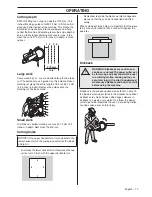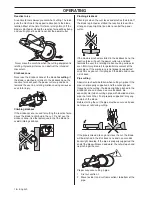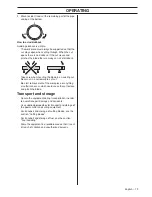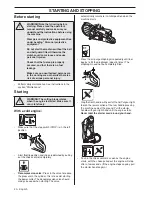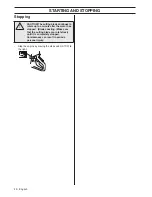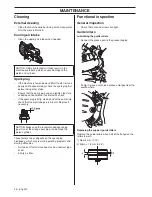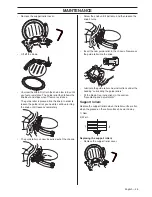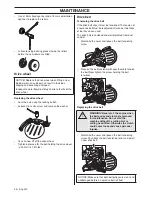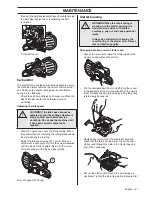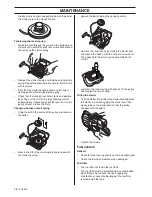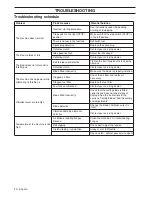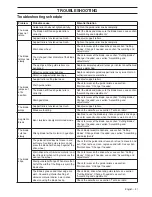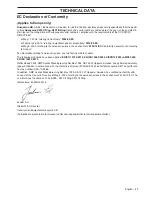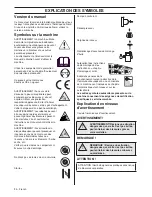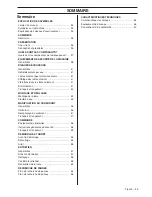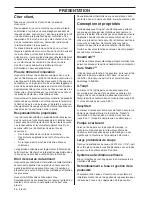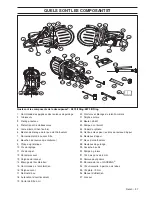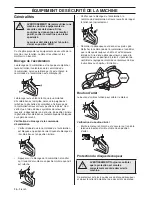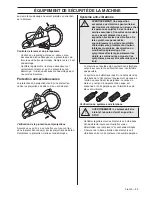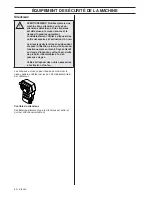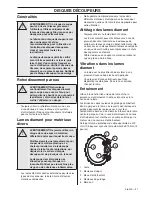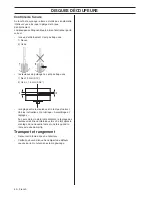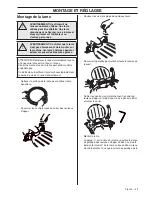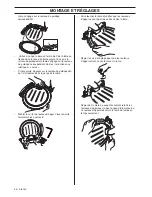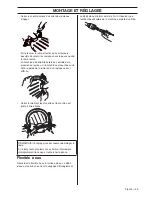
English – 31
TROUBLESHOOTING
Troubleshooting schedule
Problem
Probable cause
Potential Solution
The blade
does not
rotate.
Guide roller knobs not tightened fully.
Tighten the guide roller knobs completly.
The blade not fitted on guide rollers
correctly.
Refit the blade and make sure the blade moves, see section
”Assembling and adjustments”.
Support rollers tensioned too much.
Readjust support rollers.
The blade
rotates too
slowly.
Support rollers tensioned too much.
Tighten the guide roller knobs completly.
Worn drive wheel.
Check for wear on the drive wheel, see section ”Cutting
blades”. Change if needed, see section ”Assembling and
adjustments”.
The V-shaped inner diameter of the blade
is worn.
Check for wear of the blade, see section ”Cutting blades”.
Change if needed, see section ”Assembling and
adjustments”.
The springs on the guide rollers are
weakened.
Replace complete guide roller assy or contact an authorised
service workshop.
Defective guide roller bearings.
Replace complete guide/support roller assy or contact an
authorised service workshop.
Defective support roller bearings.
The blade
jumps out
of its
position.
Support roller setting too loose.
Readjust support rollers.
Worn guide rollers.
Check for wear on the guide rollers, see section
”Maintenance”. Change if needed.
The blade not fitted on guide rollers
correctly.
Refit the blade and make sure the blade moves, see section
”Assembling and adjustments”.
Damaged blade.
Check for wear of the blade, see section ”Cutting blades”.
Change if needed, see section ”Assembling and
adjustments”.
The blade
warps.
Support rollers tensioned too much.
Readjust support rollers.
Blade overheating.
Check the waterflow, see section ”Technical data”
Segments
break.
Bent, twisted or badly maintained blade.
Continue to use the blade only if one segment is missing or
leave for reconstruction when the blade is worn max 50 %.
Check for wear of the blade, see section ”Cutting blades”.
Change if needed, see section ”Assembling and
adjustments”.
The blade
cuts too
slowly.
Wrong blade for the material in question.
Check blade recommendations, see section ”Cutting
blades”. Change blade if needed, see section ”Assembling
and adjustments”.
The blade
slips.
The guide rollers does not move in and
out freely. A seized guide roller can not
press the blade hard enough against the
drive wheel.
Check that the guide roller sleeves are free to move in and
out. If not, remove, clean, regrease and refit. See section
”Maintenance”. Change if needed.
Worn drive wheel. Abrasive material and
too little water when cutting increases the
wear on the wheel.
Check for wear on the drive wheel, see section ”Cutting
blades”. Change if needed, see section ”Assembling and
adjustments”.
Worn guide roller flange. When more than
half of the width of the flange is worn the
blade slips.
Check for wear on the guide rollers, see section
”Maintenance”. Change if needed.
The blade’s groove and inner edge are
worn. Caused by inferior flushing of
abrasive material and/or a worn drive
wheel causing the blade to slip.
Check blade, drive wheel and guide rollers, see section
”Cutting blades”. Change if needed, see section
”Assembling and adjustments”.
Check the waterflow, see section ”Technical data”
Summary of Contents for K970 II Ring
Page 135: ......

